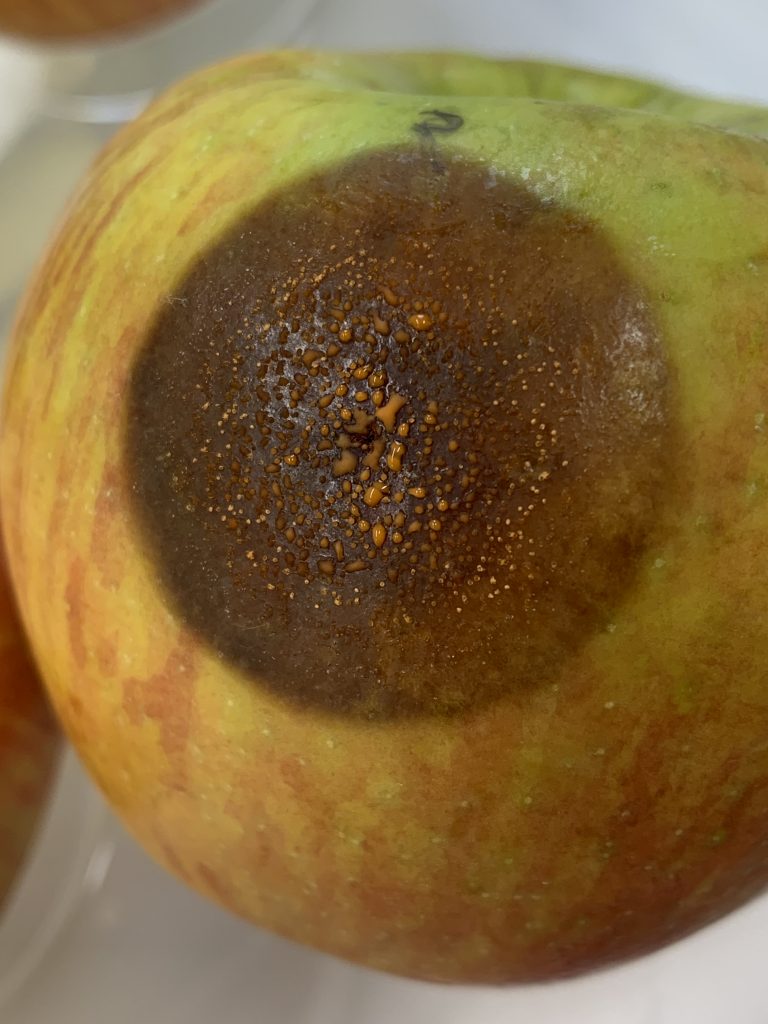Aug 24, 2021Apple summer rots, sooty blotch and flyspeck addressed in Wisconsin
As the apple harvest season is upon us in Wisconsin, apple fruit diseases may become more apparent and their impacts on fruit quality and yield do not go unnoticed.
Understanding when the pathogens infect, the conditions conducive to their spread and management strategies can minimize their impact on apple production.
A review of several important apple fruit diseases is provided herein.
One of the most common fruit rot diseases that apple growers encounter is black rot. This disease is caused by a fungal pathogen (Botryosphaeria obtusa). Symptoms appear as black and brown concentric rings on fruits, usually containing small, black fungal fruiting structures. These symptoms are typically found at the calyx end (bottom) of the apple fruit (Figure 1 at top). If we encounter a warm spring, infections are likely to occur. These infections can occur 4 to 6 weeks prior to harvest so well-timed preventative fungicides during these periods are important. The black rot pathogen can also infect leaves (frogeye leaf spot) and branches (canker infections). The optimum temperature for fruit infections is 68-75° F.
Bitter Rot


Bitter rot is becoming a more common occurrence in apple production in Wisconsin. This disease is caused by fungi in the genus Colletotrichum. Symptoms appear as sunken, circular lesions that are light brown to dark brown in color. Fungal fruiting structures are formed in concentric circles in the lesions, and these structures can produce a lot of spores. During wet conditions salmon to orange-colored spores exude in a circular pattern (Figure 2). Cross-sections of infected apples may reveal a V-shaped lesion; this symptom distinguishes bitter rot from white rot where lesions are more cylindrical. Fruits are susceptible to infection at all developmental stages, and lesion expansion occurs rapidly at 86°F. Epidemics are most severe under warm and wet conditions. Fruit infections are most common from mid-to late summer but can develop before, during or after bloom in some cases.
White Rot


White rot has also been identified more frequently in Wisconsin. Symptoms of black rot and white rot are often confused, and symptoms of each disease can show up around the same time. However, the white rot pathogen (Botryosphaeria dothidea) does not cause leaf spots like the black rot pathogen. Lesions that form on the fruit are sunken, circular brown to tan spots (Figure 3), sometimes surrounded by a red margin (or dark purple margin on red fruits). The rot extends towards the core of the fruit in a cylindrical shape; unlike bitter rot which extends in a V-shape. In warm conditions (77-86°F) the fruits turn a light brown to tan color and are soft and watery. In cool conditions, the symptoms can resemble those seen with black rot – firm rotted areas that are darker in color. The fungus can form in the lesions on the fruit and spores can spread from these lesions.
Sooty Blotch and Flyspeck (SBFS)


SBFS is a common and cosmetic issue of apple fruits that can lower fruit quality. Numerous fungi have been associated with SBFS; these fungi grow superficially on the fruit, unlike the rot diseases mentioned above which can affect both the skin and the flesh of the apple. Symptoms of SBFS can present differently on fruit but typically appear as dark blotches on the fruit (SB) and small specks clustered together (FS) (Figure 4). The fungi overwinter on fruits, twigs, and leaves of other host plants including apple and pear, and infections of apple begin in late May and early June. NEWA has a risk prediction model for the SBFS disease complex, more on this model can be found in a previous article on SBFS.
Control can be achieved with good sanitation practices and the use of protectant fungicides.
- Remove diseased fruit throughout the growing season to reduce the risk of spread of the pathogens.
- Remove mummified fruit, cankers, and dead branches – these tissues can serve as sources of inoculum for new infections.
- Shoots affected by fire blight, including current season blighted shoots (important for bitter rot control) and old shoots should be removed to prevent buildup of the pathogen.
- Prunings should not be left around the orchard as they can also be colonized by rot fungi and serve as an additional source of inoculum; prunings should be chopped to remove the bark.
- Tight clustered fruit can provide a conducive microclimate for disease development and limit spray coverage so proper thinning is recommended.
- When it comes to fungicide applications, be aware of pre-harvest intervals (PHI) on the chemistries you select.
- Captan: effective against the summer fruit rots and SBFS when applied at a higher rate and at spray intervals of no more than 2 weeks.
- Strobilurins (ex. Flint Extra, Sovran, Pristine) are effective against SBFS and fruit rots, however tank mixing with captan is better
- SDHI (FRAC 7) + strobilurin (FRAC 11) fungicides (ex. Luna Sensation, Merivon) are effective against SBFS and fruit rot diseases
- DMI (FRAC 3) fungicides (ex. Indar, Inspire Super) are effective against SBFS but not against fruit rot
- If you rely on DMI fungicides and/or SDHI fungicides for apple scab control in the spring, then you should not use them for summer fruit diseases if apple scab lesions are visible in the orchard. Applying these fungicides to active scab lesions enhances the risk of development of fungicide resistance.
- For organic apple growers, liquid lime sulfur or elemental sulfur are effective against SBFS, but there is a risk of phytotoxicity to the fruit. Oxidate, Serenade, potassium bicarbonate, and Regalia may be effective in low disease pressure situations but have performed inconsistently in field trials. These products will require frequent re-application in high disease pressure conditions.
– Leslie Holland, Wisconsin Fruit Program
Figure 1 at top: Black rot lesion on apple.















